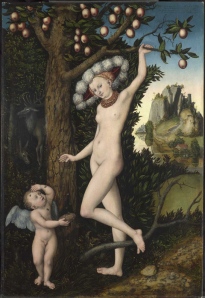Tags
Beethoven, Benda, Bleib bei uns denn es will Abend werden, cantata, Caravaggio, Christ lag in Todesbanden, composition, Couperin, Cupid Complaining to Venus, Easter, Goya, iconography, John Eliot Gardiner, L'Orfeo, Latin, Lucas Cranach the Elder, Martin Luther, Monteverdi, Monteverdi Choir, Music in the Castle of Heaven, Orchestre Révolutionnaire et Romantique, painting, Scarlatti, St. Luke, The Supper at Emmaus, Weimar

Cupid Complaining to Venus
“That certain artists and composers are of the same generation doesn’t always mean that there is a significant link between them. But Goya and Beethoven share the sense of being possessed by inner demons. They also share an awareness of humanity at its most squalid and disreputable – particularly in the context of war,” observes Sir John Eliot Gardiner. A revolutionizing exponent of the music of Claudio Monteverdi and Johann Sebastian Bach as well as Ludwig van Beethoven, Mr. Gardiner is the founding music director of the Monteverdi Choir and the period-instrument Orchestre Révolutionnaire et Romantique. Having discovered his profound interest in relationships between art and music during an informal conversation [last] year, I arranged for us to resume this discussion at London’s National Gallery.
Our conversation touched on Mr. Gardiner’s forthcoming book on Bach, scheduled for British publication [in] September [of 2013]. “It’s less a conventional biography,” he explains, “than a series of fourteen contextualizing approaches to Bach through the music.” For instance, one chapter explores “the family ramifications and what it meant to be a Bach, while comparing Europe’s parallel musical dynasties at the time: the Bachs in Germany, the Scarlattis in Italy, the Bendas of Bohemia and the Couperins in France. Another chapter . . . investigates Bach’s relationship to Martin Luther and the complexity of the religious element in Bach’s music. And on it goes.”
Lucas Cranach the Elder, Luther’s close friend and portraitist, is a painter Mr. Gardiner identifies with Bach. “Cranach is so much part of Lutheran iconography that he’s an inescapable part of Bach’s heritage, and Bach must have been introduced to his work during his years in Weimar, where Cranach’s house still stands.”
Cranach’s Cupid Complaining to Venus (c. 1525) uses pagan imagery to present a Lutheran moral that Bach would have recognized. The winged child of the goddess of love protests being stung by bees while stealing a honeycomb. A Latin inscription in the upper right reads, “life’s pleasure mingled with pain.”
“I always feel the plague and the Dance of Death hovering in the background of Cranach’s work,” Mr. Gardiner says. “And death plagued Bach throughout his life. He was orphaned at nine, and as an adult lost ten or eleven of his twenty-three children, not to mention his first wife. Bach so wonderfully evokes the concept of the Dance of Death in his Easter cantata, Christ lag in Todesbanden (BWV 4), based on Martin Luther’s eponymous hymn of the Resurrection and the struggle between life and death.”

The Supper at Emmaus
Related to this theme, Caravaggio‘s powerfully emotional The Supper at Emmaus (1601) is a painting whose resonance, for Mr. Gardiner, embraces Bach, Beethoven and Caravaggio’s contemporary Monteverdi. Caravaggio depicts the post-Crucifixion episode, in St. Luke, when an apparent stranger sups at an inn with two of Christ’s disciples. As he blesses the bread, the disciples recognize him as Christ. To the two disciples Caravaggio adds a bemused innkeeper.
“By means of sharp light and shadow, gesture and illusion, Caravaggio re-creates the sheer wonderment of a miracle. At the center is this beardless, tranquil stranger whose hand raised in benediction almost reaches out beyond the canvas to the viewer. The two disciples react so differently to their sudden awareness – the one on the right with his outstretched arms seems ready to embrace Christ. The disciple on the left stares at Christ’s face and is ready to spring from his chair in astonishment and joy. Meanwhile the puzzled innkeeper can’t understand what’s going on.”
The disciples’ excited gestures are those of everyday people, I note. The whole composition embodies realistic shock. Everything around the calm central figure is off-balance; shadows are exaggerated as if caused by a flash of light, a fruit basket teeters at the table’s edge. Hands balloon out of proportion – fingertips oversized, arms foreshortened. Caravaggio confronts us with a silent emotional explosion that transcends even the most eloquent speech.
“You certainly find this emotion in Monteverdi,” Mr. Gardiner says. “Consider the moment in his opera L’Orfeo, when Orfeo learns of Euridice’s death and responds with a single word, the soft, anguished cry, ‘Ohimè (Alas).’ Yet over a century after Monteverdi’s day, Caravaggio’s emotion resonates strongly in Bach’s cantatas for the second and third days of Easter, especially the wonderful Road to Emmaus, Bleib bei uns, denn es will Abend werden (BWV 6). And this epochal, iconoclastic work anticipates Beethoven, indeed all those subversive composers who would not follow the rules.”
Barrymore Laurence Scherer – The Wall Street Journal
